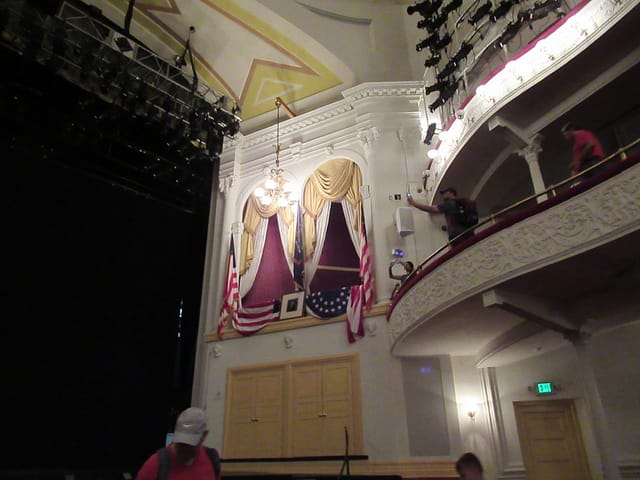So, here’s the thing about history: sometimes you read about it in textbooks, nod sagely, maybe even ace a quiz on the date, and then promptly file it away in your brain’s “Random Trivia for Jeopardy” folder. But sometimes (if you’re very lucky), you stumble into the actual physical space where it happened. And that’s when your brain short-circuits because the ghosts of the past are suddenly real estate you’re standing in.
That was me at Ford’s Theatre and the Petersen House (aka “the house where Lincoln died”). Spoiler: I was so dumbfounded that I completely forgot to take pictures at the Petersen House. Whoops.

Act One: A Night at the Theatre (Without the Fun Part)
Ford’s Theatre looks like your classic charming 19th-century playhouse — gilded balconies, velvet curtains, the whole shebang. You can almost imagine the orchestra warming up for a lighthearted comedy. Except instead of thinking about witty one-liners, you’re staring at the Presidential Box where Abraham Lincoln spent his final evening.
The box is draped in flags, preserved as it looked on April 14, 1865. Except your brain won’t let you just appreciate the interior design. Nope. It won’t stop screaming: “This is where John Wilkes Booth, a famous actor, leapt in like a deranged action star, shot the President, broke his leg, and somehow still got away in the chaos.”
It’s unsettling. It’s fascinating. It’s a little like watching a play, except the play doesn’t end with polite applause — it ends with a nation spiraling into grief and chaos.

Act Two: Across the Street, History Holds Its Breath
Here’s where my “Kristen Experiments” self totally failed at blogging: I did not take pictures inside the Petersen House. Why? Because the second I stepped in, it felt like my brain was smacked with a frying pan of reality.
This house is small. It’s ordinary. If you walked past it today, you’d probably think, “Cute brick townhouse, probably a nightmare in D.C. rent.” But inside, in a cramped back bedroom, Abraham Lincoln’s 6’4” frame lay stretched across a bed far too small for him. He fought for his life for hours, surrounded by doctors, cabinet members, and grieving friends. At 7:22 a.m. the next day, he was gone.
And standing there — in that room — the weight of it hit me so hard I couldn’t even lift my phone. Because this wasn’t just a “history happened here” moment. This was the literal space where the life of one of the most significant figures in American history ended.

Curtain Call: What Stuck with Me
Here’s what makes visiting both sites so wild: Ford’s Theatre and the Petersen House are separated by one street. Just a handful of steps took Lincoln from enjoying a play to fighting for his life. That short distance changed the trajectory of the entire country.
I thought I’d walk away with a camera roll of cool shots to show off. Instead, I walked away with a strange silence. The kind that comes when history stops being abstract and instead smacks you in the gut with its closeness.
So, yeah. I didn’t get the pictures. But I did get the feeling. And maybe that’s better.











